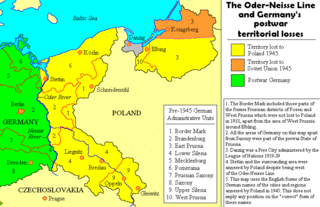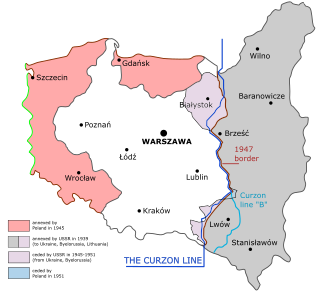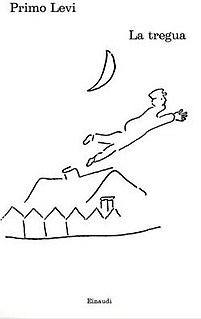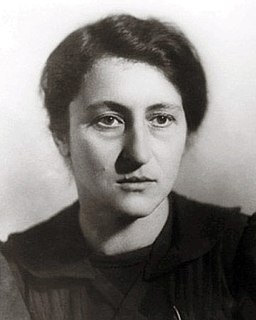 W
WThe history of Poland from 1945 to 1989 spans the period of communist rule imposed over Poland after the end of World War II. These years, while featuring general industrialization, urbanization and many improvements in the standard of living, were marred by early Stalinist repressions, social unrest, political strife and severe economic difficulties.
 W
WThe Provisional Government of National Unity was a government formed by the decree of the State National Council on 28 June 1945. It was created as a coalition between the Polish Workers' Party and politicians from close political sphere of Stanisław Mikołajczyk, the former prime minister of the Polish government-in-exile based in London.
 W
WThe anti-communist resistance in Poland, also referred to as the Polish anti-Communist insurrection fought between 1944 and 1953, was an armed struggle by the Polish Underground against the Soviet takeover of Poland at the end of World War II in Europe. The guerrilla warfare conducted by the resistance movement formed during the war, included an array of military attacks launched against Communist prisons, state security offices, detention facilities for political prisoners, and prison camps set up across the country by the Stalinist authorities.
 W
WThe battle for trade was an element of the state politics in the early period of communist takeover of Poland (1946–49) according to which new laws and regulations succeeded in significantly decreasing the size of the private sector in Polish trade, in order to facilitate the transformation of Polish economy from capitalism to Soviet communism's planned economy.
 W
WThe Commission for the Determination of Place Names was a commission of the Polish Department of Public Administration, founded in January 1946. Its mission was the establishment of toponyms for places, villages, towns and cities in the former eastern territories of Germany.
 W
WAs a result of World War II, Poland's borders were shifted west. Within Poland's new boundaries there remained a substantial number of ethnic Germans, who were expelled from Poland until 1951. The remaining former German citizens were primarily autochthons, who were allowed to stay in post-war Poland after declaring Polish nationality in a verification process. According to article 116 of the German constitution, all former German citizens may be "re-granted German citizenship on application" and are "considered as not having been deprived of their German citizenship if they have established their domicile in Germany after May 8, 1945 and have not expressed a contrary intention." This regulation allowed the autochthons, and ethnic Germans permitted to stay in Poland, to reclaim German citizenship and settle in West Germany. In addition to those groups, a substantial number of Poles who never had German citizenship were emigrating to West Germany during the period of the People's Republic of Poland for political and economic reasons.
 W
WDuring the later stages of World War II and the post-war period, Germans and Volksdeutsche fled or were expelled from various Eastern and Central European countries, including Czechoslovakia, and the former German provinces of Silesia, Pomerania, and East Prussia, which were annexed by Poland and the Soviet Union. In 1957, Walter Schlesinger discussed reasons for these actions, which reversed the effects of German eastward colonization and expansion: he concluded, "it was a devastating result of twelve years of National Socialist Eastern Policy." The idea to expel the Germans from the annexed territories was proposed by Winston Churchill, in conjunction with the Polish and Czechoslovak exile governments in London at least since 1942. In late 1944 the Czechoslovak exile government pressed the Allies to espouse the principle of German population transfers. On the other hand, Polish prime minister Tomasz Arciszewski, in an interview for The Sunday Times on 17 December 1944, supported the annexation of Warmia-Masuria, Opole Regency, north-east parts of Lower Silesia, and parts of Pomerania, but he opposed the idea of expulsion. He wanted to naturalize the Germans as Polish citizens and to assimilate them.
 W
WThe flight and expulsion of Germans from Poland was the largest of a series of flights and expulsions of Germans in Europe during and after World War II. The German population fled or was expelled from all regions which are currently within the territorial boundaries of Poland, including the former eastern territories of Germany and parts of pre-war Poland.
 W
WThe Giedroyc doctrine or Giedroyc–Mieroszewski doctrine was a political doctrine that urged reconciliation among Central and Eastern European countries. It was developed by postwar Polish émigrés, and was named for Jerzy Giedroyc, a Polish émigré publicist, with significant contributions by Juliusz Mieroszewski for whom it is also sometimes named.
 W
WThe Giedroyc doctrine or Giedroyc–Mieroszewski doctrine was a political doctrine that urged reconciliation among Central and Eastern European countries. It was developed by postwar Polish émigrés, and was named for Jerzy Giedroyc, a Polish émigré publicist, with significant contributions by Juliusz Mieroszewski for whom it is also sometimes named.
 W
WThe Oder–Neisse line is the basis of most of the international border between Germany and Poland. It runs mainly along the Oder and Lusatian Neisse rivers and meets the Baltic Sea in the north, just west of the ports of Szczecin and Świnoujście.
 W
WThe Polish People's Party existed in post-World War II Poland from 1945 to 1949. In a period of increasing solidification of communist power in Poland but with the political system retaining some formal adherence to multiparty democracy principles, the PSL was a centrist non-communist party that was not allied with the communists. The PSL was defeated by the communist-based bloc in the rigged legislative elections of 1947.
 W
WThe Polish population transfers in 1944–46 from the eastern half of prewar Poland, were the forced migrations of Poles toward the end and in the aftermath of World War II. These were the result of Soviet policy that was ratified by the Allies. Similarly, the Soviet Union had enforced policies between 1939 and 1941 which targeted and expelled ethnic Poles residing in the Soviet zone of occupation following the Nazi-Soviet invasion of Poland. The second wave of expulsions resulted from the retaking of Poland by the Red Army during the Soviet counter-offensive. It took over territory for its republic of Ukraine, a shift that was ratified at the end of World War II by the Soviet Union's then Allies of the West.
 W
WThe Polish Workers' Party was a communist party in Poland from 1942 to 1948. It was founded as a reconstitution of the Communist Party of Poland (KPP) and merged with the Polish Socialist Party (PPS) in 1948 to form the Polish United Workers' Party (PZPR). From the end of World War II the PPR ruled Poland, with the Soviet Union exercising moderate influence. During the PPR years, the conspiratorial as well as legally permitted centers of opposition activity were largely eliminated, while a communist system was gradually established in the country.
 W
WThe population exchange between Poland and Soviet Ukraine at the end of World War II was based on a treaty signed on 9 September 1944 by the Ukrainian SSR with the newly-formed Polish Committee of National Liberation (PKWN) and affected an estimated 1.6 million people.
 W
WThe Recovered Territories or Regained Lands, also known as Western Borderlands, and previously as Western and Northern Territories, Postulated Territories and Returning Territories, are the former eastern territories of Germany and the Free City of Danzig that became part of Poland after World War II, at which time their former German inhabitants were forcibly deported. The rationale for the term "Recovered" was that these territories formed part of the Polish state, and were lost by Poland in different periods over the centuries. It also referred to the Piast Concept that these territories were part of the traditional Polish homeland under the Piast dynasty, after the establishment of the state in the Middle Ages. Over the centuries, however, they had become predominantly German-speaking through the processes of German eastward settlement, political expansion, as well as language shift due to assimilation of local Polish, Slavic and Baltic Prussian population. Therefore, aside from certain regions such as West Upper Silesia, Warmia and Masuria, as of 1945 most of these territories did not contain sizeable Polish-speaking communities.
 W
WSeagoing cowboys is a term used for men and ships used from 1945 to 1947 for United Nations Relief and Rehabilitation Administration and the Brethren Service Committee of the Church of the Brethren that sent livestock to war-torn countries. These seagoing cowboys made about 360 trips on 73 different ships. Most of the ships were converted World War II cargo ships with added cages and horse stalls. The Heifers for Relief project was started by the Church of the Brethren in 1942; in 1953 this became Heifer International. In the wake of the destruction caused by the Second World War, the historical peace churches in the United States sponsored relief missions to war-ravaged Europe, typically in cooperation with the United Nations Relief and Rehabilitation Administration (UNRRA). These relief missions usually took the form of transporting farm animals, by transatlantic ship, to Poland and other countries where much of the livestock had been killed in the war. The men who tended the animals aboard these boats were called seagoing cowboys. These ships moved horses, heifers, and mules as well as chicks, rabbits, and goats. Ten seagoing cowboys died on the SS Park Victory when it sank after accidental grounding in the Gulf of Finland on December 25, 1947.
 W
WAt the end of World War II, Poland underwent major changes in its territorial extent. In 1945, after the defeat of Nazi Germany, the Oder–Neisse line became its western border, and the Curzon Line its eastern border, in accordance with the decisions made first by the Allies at the Tehran Conference of 1943 where the Soviet Union demanded the recognition of the line proposed by British Foreign Secretary Lord Curzon in 1920.
 W
WThe Truce is a 1997 film directed by Francesco Rosi, written by Tonino Guerra, based on Primo Levi's memoir, The Truce. The film deals with Primo Levi's experiences returning to Italy in 1945 after the Red Army liberated the concentration camp at Auschwitz during the Second World War. This was Rosi's final film before his death in 2015.
 W
WThe Truce, titled The Reawakening in the US, is a book by the Italian author Primo Levi. It is the sequel to If This Is a Man and describes the author's experiences from the liberation of Auschwitz (Monowitz), which was a concentration camp, until he reaches home in Turin, Italy, after a long journey. He describes the situation in different displaced persons camps after the Second World War.
 W
WUnion of Polish Patriots was a political body created by Polish communists in the Soviet Union in 1943. The ZPP, unofficially controlled and directed by Joseph Stalin, became one of the founding structures of the Soviet-controlled communist government that after World War II took power in Poland.
 W
WZakerzonia is an informal name for the territories of Poland to the west of the Curzon Line which used to have sizeable Ukrainian populations, including significant Lemko, Boyko and Ruthenian populations, before the invasion of Poland by the Soviet Union and Nazi Germany in 1939, and were claimed as ethnically Ukrainian territories by Ukrainian nationalists in the aftermath of World War II.
 W
WZgoda was a labour camp , set up in February 1945 in Zgoda district of Świętochłowice, Silesia. It was controlled by the communist secret police until its closure in November of the same year.